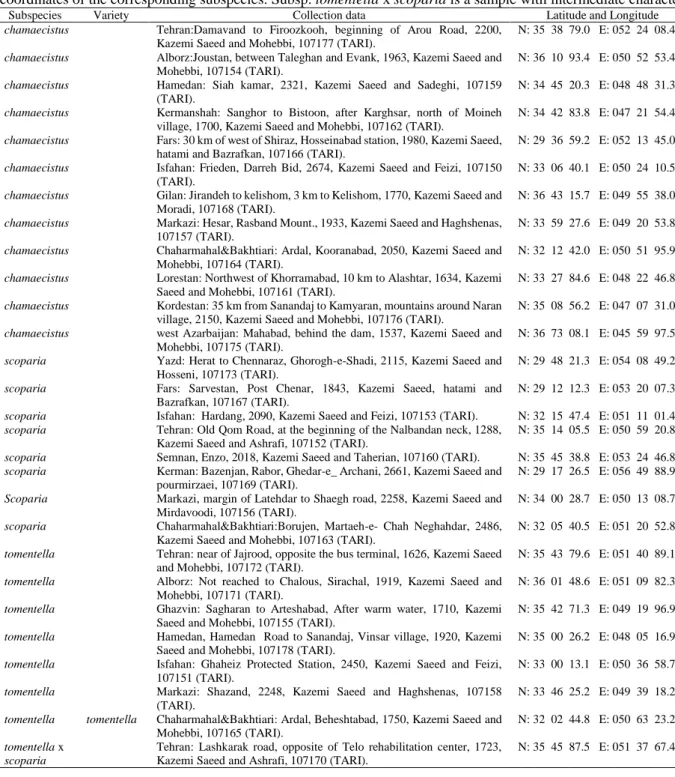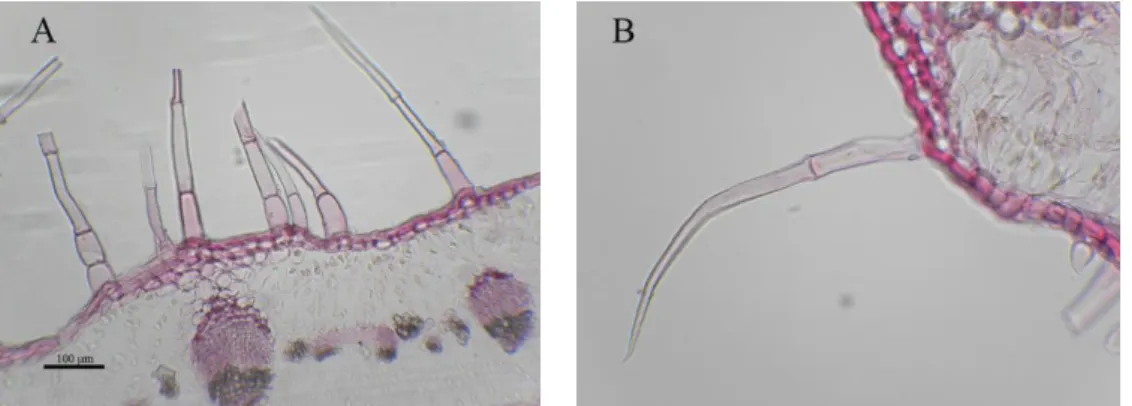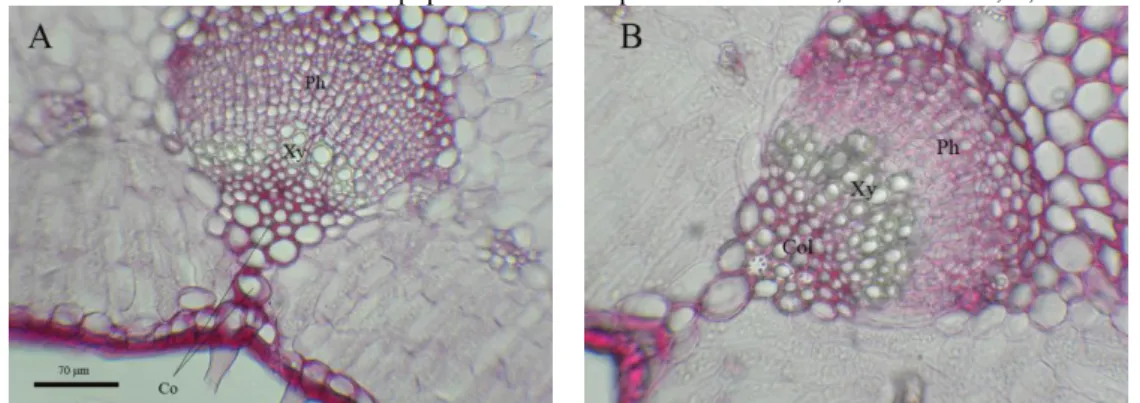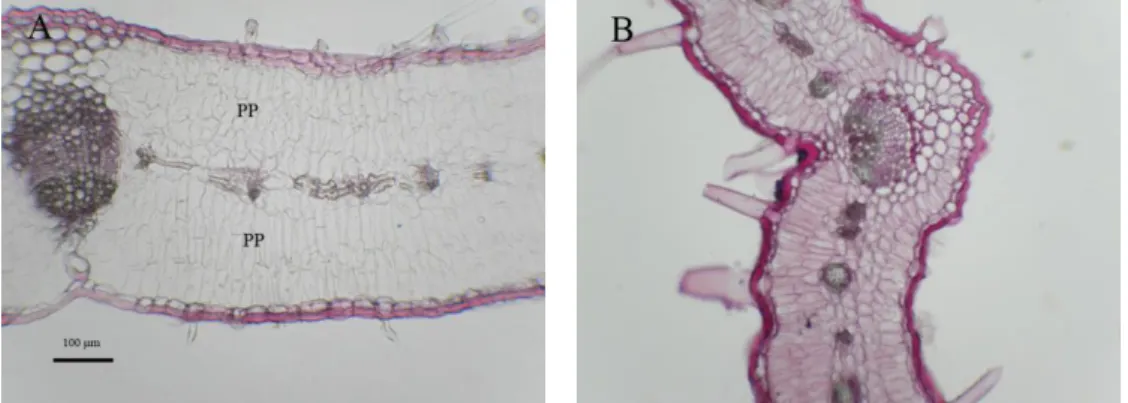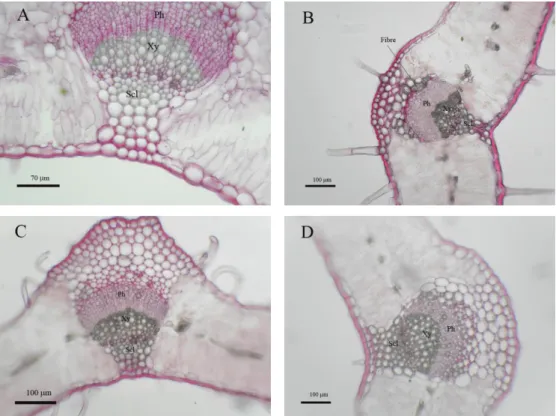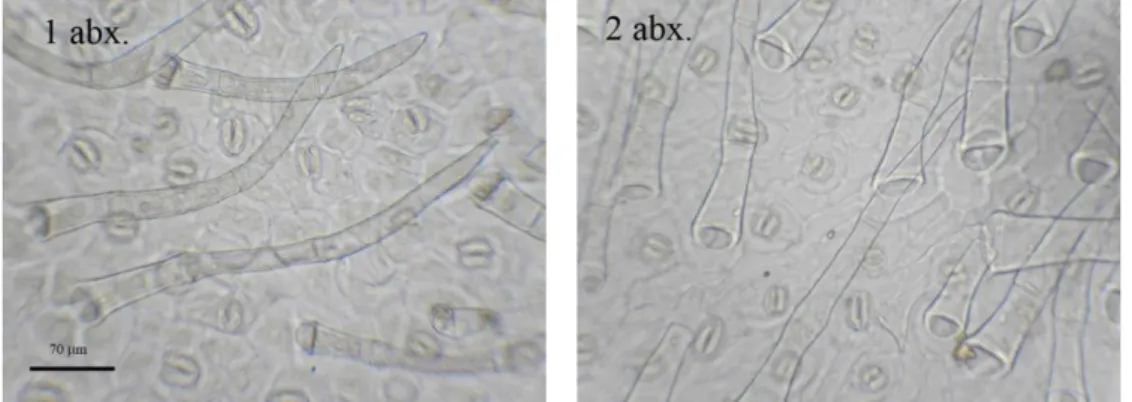FOLIAR ANATOMICAL STUDIES OF AJUGA CHAMAECISTUS (LAMIACEAE) FROM IRAN
F. Kazemi Saeed, Z. Jamzad, A. Vaziri, A. Jalili & F. Sefidkon
Received 2019. 11. 13; accepted for publication 2019. 12. 20
Kazemi Saeed, F., Jamzad, Z., Vaziri, A., Jalili, A. & Sefidkon, F. 2019. 12. 30: Foliar anatomical studies of Ajuga chamaecistus (Lamiaceae) from Iran. -Iran. J. Bot. 151-181. Tehran.
Ajuga chamaecistus Ging. ex Benth. (Lamiaceae) is a small subshrub, widely distributed in Iran. It has four subspecies including chamaecistus, scoparia, tomentella and euphrasioides, all endemics of Iran. In this study, three subspecies were collected from 16 provinces, totally 28 regions and their leaf anatomical structure was studied. The studied anatomical traits were leaf type, trichome type (glandular/non-glandular), stomata position, number of the upper and lower palisade parenchyma, number of vascular bundle, presence or absence of the fibre- Sclerenchyma, presence or absence of the vascular sheath, tissue of vascular sheath, upper and lower collenchyma as qualitative traits and thickness of the upper and lower palisade parenchyma, thickness of the upper and lower cuticle, mesophyll/ vascular bundle, diameter of lamina, adaxial and abaxial stomatal density, adaxial and abaxial stomatal length, adaxial and abaxial stomatal width as quantitative traits. This study provided valuable information on the leaf anatomical structure of A. chamaecistus. The results showed that the anatomical structure of the studied subspecies are very similar.
Although PCA analysis separated some subspecies, the anatomical traits of the leaf are not enough to separate different subspecies, to do this, other studies, such as anatomical traits of other plants structures such as petiole and stem as well as other biosystematics studies may be helpful.
Farahza Kazemi Saeed (correspondence< [email protected]>), PhD student in Biology, Payam Noor University and Research Institute of Forests & Rangelands, Ziba Jamzad, Research Institute of Forests & Rangelands, Tehran, Iran, Agricultural Research, Education and extension Organization (AREEO). -Atousa Vaziri, Department of Biology, Payame Noor University (PNU) . -Adel Jalili & Fatemeh Sefidkon, Research Institute of Forests & Rangelands, Tehran, Iran, Agricultural Research, Education and extension Organization (AREEO).
Key words: Ajuga chamaecistus; subspecies; Lamiaceae; anatomy; leaf; Iran
رب یکیموتانآ هعلاطم گ
هنوگ
Ging. ex Benth.
Ajuga chamaecistus
هریت زا انعن یئ نا
:دیعس یمظاک ازحرف
یوجشناد یرتکد هورگ تسیز رون مایپ هاگشناد یسانش
ققحم و هسسؤم نج تاقیقحت ناریا ،نارهت ،روشک عتارم و اهلگ
مج ابیز :داز داتسا هسسؤم زومآ ،تاقیقحت نامزاس ،روشک عتارم و اهلگنج تاقیقحت ناریا ،نارهت ،یزرواشک جیورت و ش
:یریزو اسوتآ تسیز هورگ رایداتسا
ارهت ،رون مایپ هاگشناد ،یسانش ناریا ،ن
:یلیلج لداع داتسا
هسسؤم زومآ ،تاقیقحت نامزاس ،روشک عتارم و اهلگنج تاقیقحت ورت و ش
ناریا ،نارهت ،یزرواشک جی
:نکدیفس همطاف داتسا
هسسؤم زومآ ،تاقیقحت نامزاس ،روشک عتارم و اهلگنج تاقیقحت ناریا ،نارهت ،یزرواشک جیورت و ش
هنوگ
Ajuga chamaecistusهنوگ زا یکی
سنج یاه
Ajuga L.هریت هب قلعتم و
Lamiaceaeیم نیا .دراد ناریا رد یعیسو شرتسگ هک دشاب
هنوگریز راهچ یاراد هنوگ
chamaecistus،
scoparia،
tomentellaو
euphrasioides
یم ناریا یراصحنا یگمه هک تسا
،قیقحت نیا رد .دنشاب
زا هس رد دوجوم هنوگریز اعومجم و روشک ناتسا
61عمج هنومن
82رارق هعلاطم دروم اهنآ گرب یحیرشت راتخاس راب نیلوا یارب و دیدرگ یروآ
152 Foliar anatomical studies of Ajuga chamaecistus IRAN. J. BOT. 25 (2), 2019
تفرگ کرک عون ،گرب پیت :زا دندوب ترابع هعلاطم دروم یحیرشت تافص . (
هدغ هدغ ریغ ای یا هیال دادعت ،هنزور تیعقوم ،)یا
وف میشناراپ یاه و یناق
ربیف دوجو مدع ای دوجو ،گربگر یدنوآ تاجتسد دادعت ،یحشرت لاناک دوجو ،یناتحت -
تفاب عون ،یدنوآ فالغ دوجو مدع ای دوجو ،میشنارلکسا
غ ن ،یناتحت و یناقوف لوکیتوک تماخض ،یناتحت و یناقوف میشناراپ تماخض و یفیک تافص ناونع هب یناتحت و یناقوف میشنالک دوجو ،یدنوآ فال س
تب
مک تافص ناونع هب یناتحت و یناقوف هنزور ضرع و یناتحت و یناقوف هنزور لوط ،یناتحت و یناقوف هنزور مکارت ،کنهپ رطق ،دنوآ هب لیفوزم ی
. نیا
هنوگ گرب یحیرشت راتخاس دروم رد یدنمشزرا تاعالطا قیقحت
Ajuga chamaecistusیحیرشت راتخاس هک داد ناشن جیاتن .دومن مهارف
هنوگریز یواکاو اب هچرگا و دنراد تهابش رگیدکی هب رایسب هدش هعلاطم یاه هروظنم دنچ یاه
(PCA)
هنوگریز زا یدادعت اما ،دندش یزاسادج اه
ت تافص هنوگریز یزاسادج یارب ییاهنت هب گرب یحیرش امتح و تسین یفاک فلتخم یاه
مادنا یحیرشت تافص نآ اب هارمه ننام یرگید یاه
گربمد د
نینچمه و هقاس و رب
ر یس یکیتامتسیسویب یاه دروم دیاب زین
دنریگ رارق هجوت
.INTRODUCTION
Ajuga chamaecistus Ging. ex Benth. is one of the species of Ajuga L. (Lamiaceae). This genus has six species in Iran, some of which include several infra- specific taxa. Ajuga chamaecistus is the most wide- spread species in Iran. The plant is a small shrub, with violet flowers. It is also distributed in Afghanistan, Central Asia, east Turkey, the Caucasus and Iraq and usually grows in mountainous or rocky slopes. There are four endemic infraspecific taxa in Iran as follows:
-subsp. chamaecistus: It is an endemic subspecies of Iran and is distributed in the northwest, west and center of Iran (Azarbaijan, Kurdestan, Hamedan, Lorestan, Markazi, Gilan, Kermanshah, Isfahan, Chaharmahal &
Bakhtiari, Fars, Alborz and Tehran provinces).
-subsp. scoparia: It is also an endemic subspecies of Iran and its habitat is in west, center and south of Iran (Isfahan, Chaharmahal & Bakhtiari, Markazi, Yazd, Fars, Kerman, Semnan and Tehran provinces).
-subsp. tomentella: It is also an endemic subspecies of Iran and its habitat is in the west, center and south of Iran (Isfahan, Chaharmahal & Bakhtiari, Markazi, Hamedan, Gazvin, Alborz and Tehran provinces).
-subsp.euphrasioides: This taxon is endemic of Iran and is distributed in center of Iran (Isfahan and Chaharmahal & Bakhtiari provinces), (Jamzad, 2012).
It should be mentioned that in this study no plants of this subspecies could be collected, so it is not included in our study.
The high morphological variation in the species has led to describing infra-specific taxa. There are overlapping characters in different taxa which makes it difficult to define the boundary of each taxon. We studied the anatomical characters to see if there is diagnostic traits that can help to define the taxa.
Anatomical studies may help in this regard. Today, all aspects of plant anatomy are considered by plant taxonomists and many findings have been obtained in this area (Akhani and Forther, 1994; Ai, 1989; Cutter,
1971). Some scientists such as Metcalf & Chalk (1985), Heywood (1985), Carlquist (1961) and Rudall (1994) beleived that anatomical studies are very important and should not be ignored. Carlquist (1975) emphasizes anatomical-systematical relationships. Vast anatomical studies are performed in order to better understanding the relationships between the different taxa of Lamiaceae family. The application of anatomical traits of plants in the mint family has often led to the solution of the taxonomical problems (Bokhari and Hedge, 1971).
Although a few species of the genus Ajuga are investigated anatomically (Akçin & al., 2006; Ghitä &
al. 2012; Çali, 2014, Sönmez and Köse, 2017), there is no anatomical study of Ajuga chamaecistus in the literatures. In the present research we give detailed description of anatomical characteristics of the leaves of the species and its subspecies.
MATERIALS AND MEDHODS
A total of 28 specimens of three subspecies of Ajuga chamaecistus were collected from different provinces, where the species was distributed, during the flowering period. A list of the specimens, systematic positions, locality and geographical coordinates of the corresponding subspecies is given in table 1. The fresh specimens were kept in 70% alcohol. Transverse sections were made by hand using commercial razor blades. The cuttings were cleared with sodium hypochlorite, stained with carmine-vest and methyl green and mounted in gelatin. To study the density, length and width of the stomata, a piece of the leaf epidermis was separated. The prepared samples were studied and measured by light microscope model CH30. Pictures were taken by a Nikon digital camera model COLPIX P90. Qualitative and quantitative data were analyzed by principal component analysis (PCA) using version 16 of minitab software and position of specimens on the coordinate axes and ordination of
them was performed. For analysis of the qualitative traits, zero and one method were used. The trait of the palisade parenchyma layers was considered as a qualitative trait, because the number of the layers varied between one and three. Therefore, for this trait, if the
number of layers was a mixture of 1 or 2, the code zero, and a mixture 2 or 3, the code 1 were considered. Trait of the density of the glandular trichomes were considered as a qualitative trait, either as low or high numbers, and were analyzed by zero and one method.
Table 1. The studied specimens of Ajuga chamaecistus and its subspecies, collection data and geographical coordinates of the corresponding subspecies. Subsp. tomentella x scoparia is a sample with intermediate characters.
Subspecies Variety Collection data Latitude and Longitude
chamaecistus Tehran:Damavand to Firoozkooh, beginning of Arou Road, 2200, Kazemi Saeed and Mohebbi, 107177 (TARI).
N: 35 38 79.0 E: 052 24 08.4
chamaecistus Alborz:Joustan, between Taleghan and Evank, 1963, Kazemi Saeed and Mohebbi, 107154 (TARI).
N: 36 10 93.4 E: 050 52 53.4
chamaecistus Hamedan: Siah kamar, 2321, Kazemi Saeed and Sadeghi, 107159 (TARI).
N: 34 45 20.3 E: 048 48 31.3
chamaecistus Kermanshah: Sanghor to Bistoon, after Karghsar, north of Moineh village, 1700, Kazemi Saeed and Mohebbi, 107162 (TARI).
N: 34 42 83.8 E: 047 21 54.4
chamaecistus Fars: 30 km of west of Shiraz, Hosseinabad station, 1980, Kazemi Saeed, hatami and Bazrafkan, 107166 (TARI).
N: 29 36 59.2 E: 052 13 45.0
chamaecistus Isfahan: Frieden, Darreh Bid, 2674, Kazemi Saeed and Feizi, 107150 (TARI).
N: 33 06 40.1 E: 050 24 10.5
chamaecistus Gilan: Jirandeh to kelishom, 3 km to Kelishom, 1770, Kazemi Saeed and Moradi, 107168 (TARI).
N: 36 43 15.7 E: 049 55 38.0
chamaecistus Markazi: Hesar, Rasband Mount., 1933, Kazemi Saeed and Haghshenas, 107157 (TARI).
N: 33 59 27.6 E: 049 20 53.8
chamaecistus Chaharmahal&Bakhtiari: Ardal, Kooranabad, 2050, Kazemi Saeed and Mohebbi, 107164 (TARI).
N: 32 12 42.0 E: 050 51 95.9
chamaecistus Lorestan: Northwest of Khorramabad, 10 km to Alashtar, 1634, Kazemi Saeed and Mohebbi, 107161 (TARI).
N: 33 27 84.6 E: 048 22 46.8
chamaecistus Kordestan: 35 km from Sanandaj to Kamyaran, mountains around Naran village, 2150, Kazemi Saeed and Mohebbi, 107176 (TARI).
N: 35 08 56.2 E: 047 07 31.0
chamaecistus west Azarbaijan: Mahabad, behind the dam, 1537, Kazemi Saeed and Mohebbi, 107175 (TARI).
N: 36 73 08.1 E: 045 59 97.5
scoparia Yazd: Herat to Chennaraz, Ghorogh-e-Shadi, 2115, Kazemi Saeed and Hosseni, 107173 (TARI).
N: 29 48 21.3 E: 054 08 49.2
scoparia Fars: Sarvestan, Post Chenar, 1843, Kazemi Saeed, hatami and Bazrafkan, 107167 (TARI).
N: 29 12 12.3 E: 053 20 07.3
scoparia Isfahan: Hardang, 2090, Kazemi Saeed and Feizi, 107153 (TARI). N: 32 15 47.4 E: 051 11 01.4 scoparia Tehran: Old Qom Road, at the beginning of the Nalbandan neck, 1288,
Kazemi Saeed and Ashrafi, 107152 (TARI).
N: 35 14 05.5 E: 050 59 20.8
scoparia Semnan, Enzo, 2018, Kazemi Saeed and Taherian, 107160 (TARI). N: 35 45 38.8 E: 053 24 46.8 scoparia Kerman: Bazenjan, Rabor, Ghedar-e_ Archani, 2661, Kazemi Saeed and
pourmirzaei, 107169 (TARI).
N: 29 17 26.5 E: 056 49 88.9
Scoparia Markazi, margin of Latehdar to Shaegh road, 2258, Kazemi Saeed and Mirdavoodi, 107156 (TARI).
N: 34 00 28.7 E: 050 13 08.7
scoparia Chaharmahal&Bakhtiari:Borujen, Martaeh-e- Chah Neghahdar, 2486, Kazemi Saeed and Mohebbi, 107163 (TARI).
N: 32 05 40.5 E: 051 20 52.8
tomentella Tehran: near of Jajrood, opposite the bus terminal, 1626, Kazemi Saeed and Mohebbi, 107172 (TARI).
N: 35 43 79.6 E: 051 40 89.1
tomentella Alborz: Not reached to Chalous, Sirachal, 1919, Kazemi Saeed and Mohebbi, 107171 (TARI).
N: 36 01 48.6 E: 051 09 82.3
tomentella Ghazvin: Sagharan to Arteshabad, After warm water, 1710, Kazemi Saeed and Mohebbi, 107155 (TARI).
N: 35 42 71.3 E: 049 19 96.9
tomentella Hamedan, Hamedan Road to Sanandaj, Vinsar village, 1920, Kazemi Saeed and Mohebbi, 107178 (TARI).
N: 35 00 26.2 E: 048 05 16.9
tomentella Isfahan: Ghaheiz Protected Station, 2450, Kazemi Saeed and Feizi, 107151 (TARI).
N: 33 00 13.1 E: 050 36 58.7
tomentella Markazi: Shazand, 2248, Kazemi Saeed and Haghshenas, 107158 (TARI).
N: 33 46 25.2 E: 049 39 18.2
tomentella tomentella Chaharmahal&Bakhtiari: Ardal, Beheshtabad, 1750, Kazemi Saeed and Mohebbi, 107165 (TARI).
N: 32 02 44.8 E: 050 63 23.2
tomentella x scoparia
Tehran: Lashkarak road, opposite of Telo rehabilitation center, 1723, Kazemi Saeed and Ashrafi, 107170 (TARI).
N: 35 45 87.5 E: 051 37 67.4
154 Foliar anatomical studies of Ajuga chamaecistus IRAN. J. BOT. 25 (2), 2019
RESULTS
The results of the leaf anatomical studies of the 28 samples are presented in the tables 2 and 3 and their images in the figs. 1-40. The leaf type in all samples was isobilateral. However, in some samples it tends to become spongy. The highest diameter of lamina was related to subsp. scoparia of Bezenjan specimen with 469.2 μm and the lowest to subsp. tomentella of Jajrood specimen with 214.2 μm. Leaves of all samples had stomata at both upper and lower surfaces. In the adaxial surface, subsp. chamaecistus of Mahabad sample with 190.78 and the same subspecies of kelishom with 68.4 number per unit area (mm2) had the highest and lowest stomatal density, respectively. In the abaxial surface, subsp. chamaecistus of Mahabad and subsp. scoparia of Post Chenar sample with 215.93 had the highest number of stomata per unit area (mm2), while the subsp.
scoparia of the Enzo sample with 60.53 had the lowest.
Regarding to stomatal length of the upper surface, the subsp. tomentella f the Ghahiz sample with 37.5μm and subsp. chamaecistus of the Mahabad sample with 26.25 μm had the highest and lowest stomatal length, respectively. At the lower surface, subsp. chamaecistus of the kelishom specimen with 38.33μm had the highest and subsp. tomentella x scoparia of the Telo sample with 22.5 μm had the lowest stomatal length. The maximum amount of the stomatal width in the adaxial surface was observed in subsp. tomentella of the Beheshtabad sample with 25.83 μm and minimum in subsp. tomentella of the Sirachal with 19.17μm. In the abaxial surface, the highest stomata width belonged to the subsp. chamaecistus of the kelishom sample with 25.83 and the lowest belonged to subsp. tomentella of the Sirachal with 17.5 μm. The stomata type was mostly anemocytic, although the anisocytic type was observed.
The stomata were mostly flat and in some cases a little prominent. The number of the upper palisade parenchyma layers was in the most cases 2-3 layers.
Except in subsp. tomentella of the Sirachal sample, the number of the layers was mostly two. The subsp.
tomentella of the Sirachal sample often had 3 layers.
Other samples had only two or both 1and 2 layers. In the lower surface, the number of the palisade parenchyma layers were mostly both 2 and 3, or only two layers. A few samples had both 1 & 2 layers. The
subsp. tomentella of the Sagharan sample had 1 & 2 &
3 layers. The subsp. tomentella of the Sirachal sample had three and the subsp. scoparia of the Post Chenar had only one layer. The upper palisade parenchyma thickness was the highest in subsp. tomentella of the Sirachal sample with 168.13 μm and the lowest in subsp. tomentella of the Behestabad sample with 83.2 μm. The subsp. scoparia of the Latehdar sample with 171.6 and subsp. tomentella of the Jajrood with 64.13 μm showed the highest and the lowest thickness in the lower palisade parenchyma, respectively. There was one vascular bundle in the midrib and veins in all specimens. All specimens had collenchyma at both of the lower and upper surfaces, although the number of layers varied among different subspecies. Only 7 of the 28 samples lacked fibre- Sclerenchyma tissue. Also, Sclerenchyma and fibre cells were observed above the phloem of subsp. scoparia of Martaeh-e-Chah Neghahdar sample. The subsp. tomentella of Sirachal, Ghaheiz and Behestabad Samples had fiber cap. In subsp. tomentella x scoparia of Telo sample, fiber cap was being formed. Vascular bundles in all specimens completely or partially were surrounded by the vascular sheath that its tissue was parenchyma. Leaves had glandular and non- glandular trichomes on both surfaces. Non- glandular trichomes were present in all samples, while glandular trichomes were observed in most specimens, often on the lower and in some cases on both surfaces. Except subsp. chamaecistus of Kordestan sample which had glandular trichome only on the upper surface. Also, subsp. chamaecistus of Moineh, Kooranabad and Alashtar samples lacked any glandular trichome. The highest cuticle thickness of the upper surface was observed in subsp. chamaecistus of Kooranabad sample with 17.5 and the lowest in subsp.
chamaecistus of Joustan, Rasband and subsp. scoparia of Enzo samples with 7.5 μm. In the lower surface, subsp. chamaecistus of Kooranabad and subsp.
tomentella of Jajrood samples with 18.33 and subsp.
chamaecistus of Joustan with 5.83 μm had the highest and lowest cuticle thickness, respectively. The highest ratio of the mesophyll to vascular bundle in the midrib was observed in subsp. chamaecistus of Arou sample with 4.07 and the lowest in subsp. chamaecistus of Darreh Bid with 2.1.
Figs. 1-8. Transverse section of leaves of studied populations of Ajuga chamaecistus subsp. chamaecistus: 1, Arou;
2, Joustan; 3, Siahkamar; 4, Moineh; 5, Hosseinabad; 6, Darreh Bid; 7, Kelishom; 8, Rasband populations.
156 Foliar anatomical studies of Ajuga chamaecistus IRAN. J. BOT. 25 (2), 2019
Figs. 9-12. Transverse section of leaves of studied populations of Ajuga chamaecistus subsp. chamaecistus: 9, Kooranabad; 10, Alashtar; 11, Kordestan; 12, Mahabad populations. Abbreeviations: Xy=Xylem; Ph=Phloem;
PP=Palisade Parenchyma; Co=Collenchyma; Scl= Sclerenchyma.
Figs. 13-20. Transverse section of leaves of studied populations of Ajuga chamaecistus subsp. scoparia: 13, Ghorogh- e-Shadi; 14, Post Chenar; 15, Hardang; 16, Nalbandan; 17, Enzo; 18, Bazenjan; 19, Latehdar; 20, Martaeh-e- Chah Neghahdar populations.
158 Foliar anatomical studies of Ajuga chamaecistus IRAN. J. BOT. 25 (2), 2019
Figs. 21-28. Transverse section of leaves of studied populations of Ajuga chamaecistus subsp. tomentella: 21, Jajrood;
22, Sirachal; 23, Sagharan; 24, Vinsar; 25, Ghaheiz; 26, Shazand; 27, Beheshtabad; 28, Telo (tomentella x scoparia) populations.
Figs. 1-4. Stomata of the upper and lower surfaces of leaves of studied populations of Ajuga chamaecistus subsp.
chamaecistus: 1, Arou; 2, Joustan; 3, Siahkamar; 4, Moineh populations.
160 Foliar anatomical studies of Ajuga chamaecistus IRAN. J. BOT. 25 (2), 2019
Figs. 5-8. Stomata of the upper and lower surfaces of leaves of studied populations of Ajuga chamaecistus subsp.
chamaecistus: 5, Hosseinabad; 6, Darreh Bid; 7, Kelishom; 8, Rasband populations.
Figs. 9-12. Stomata of the upper and lower surfaces of leaves of studied populations of Ajuga chamaecistus subsp.
chamaecistus: 9, Kooranabad; 10, Alashtar; 11, Kordestan; 12, Mahabad populations.
162 Foliar anatomical studies of Ajuga chamaecistus IRAN. J. BOT. 25 (2), 2019
Figs. 13-16. Stomata of the upper and lower surfaces of leaves of studied populations of Ajuga chamaecistus subsp.
scoparia: 13, Ghorogh-e-Shadi; 14, Post Chenar; 15, Hardang; 16, Nalbandan populations.
Figs. 17-20. Stomata of the upper and lower surfaces of leaves of studied populations of Ajuga chamaecistus subsp.
scoparia: 17, Enzo; 18, Bazenjan; 19, Latehdar; 20, Martaeh-e- Chah Neghahdar populations.
164 Foliar anatomical studies of Ajuga chamaecistus IRAN. J. BOT. 25 (2), 2019
Figs. 21-24. Stomata of the upper and lower surfaces of leaves of studied populations of Ajuga chamaecistus subsp.
tomentella: 21, Jajrood; 22, Sirachal; 23, Sagharan; 24, Vinsar populations.
Figs. 25-28. Stomata of the upper and lower surfaces of leaves of studied populations of Ajuga chamaecistus subsp.
tomentella: 26, Shazand; 27, Beheshtabad, 28, Telo (tomentella x scoparia) populations.
166 Foliar anatomical studies of Ajuga chamaecistus IRAN. J. BOT. 25 (2), 2019
Figs. 29. Glandular trichome of leaves of studied populations of subsp. chamaecistus: A, Arou; B, Joustan; C, Siahkamar; D, Kelishom; E, Hosseinabad; F, Kordestan; G, Mahabad; subsp. scoparia: H, Post Chenar1 populations.
Figs. 29. Continued. Glandular trichome of leaves of studied populations of subsp. scoparia: I. Post Chenar2; J, Bazenjan; K, Enzo; L, Martaeh-e- Chah Neghahdar populations; subsp. tomentella: M, Jajrood; N, Sagharan; O, Sirachal; P, Vinsar populations.
168 Foliar anatomical studies of Ajuga chamaecistus IRAN. J. BOT. 25 (2), 2019
Figs. 29. Continued. Glandular trichome of leaves of studied populations of subsp. tomentella: Q, Ghaheiz1; R, Ghaheiz2; S, Ghaheiz3; T, Shazand; Z, Beheshtabad; subsp. tomentella x scoparia: U, Telo populations.
Fig. 30. Non-glandular trichome of leaves in different populations. subsp. scoparia: A, Hardang; B, Martaeh-e- Chah Neghahdar populations.
Fig. 31. Isobilateral leaf type of populations of subsp. chamaecistus: A, Arou; B, Hosseinabad populations.
Fig. 32.Vascular sheath of leaves in different populations of subsp. chamaecistus: A, Hosseinabad; B, Rasband populations.
Fig. 33. Collenchyma of leaves in different populations. subsp. scoparia: A, Ghorogh-e-Shadi: B, Bezenjan populations.
170 Foliar anatomical studies of Ajuga chamaecistus IRAN. J. BOT. 25 (2), 2019
Fig. 34. Three and one layers palisade parenchyma of leaves in different populations of subsp. tomentella: A, Sirachal;
B, subsp. scoparia: Post Chenar (lower surface) populations.
Fig. 35. Sclerenchyma of leaves in different populations of subsp. scoparia: A, Latehdar; B, Martaeh-e- Chah Neghahdar; subsp. tomentella: C, Shazand; subsp. chamaecistus: D, Kelishom populations.
Fig. 36. Cap fibre above the phloem of leaves in different populations of subsp. tomentella; A. Sirachal; B. Ghaheiz;
C. Beheshtabad; subsp. tomentella x scoparia: D, Formation of cap fibre above the phloem, Telo populations.
Fig. 37. Glandular trichome of leaves in different populations. subsp. chamaecistus: 1, Arou; 2, Darreh Bid; 3, Rasband; subsp. scoparia: 4, Enzo;subsp. tomentella: 5, Beheshtabad populations.
172 Foliar anatomical studies of Ajuga chamaecistus IRAN. J. BOT. 25 (2), 2019
Fig. 38. Non-glandular trichome phloem of leaves in different populations, 1, Kordestan,(subsp. chamaecistus); 2, Ghorogh-e-Shadi (subsp. scoparia) populations.
Fig. 39-40. Non-glandular and glandular trichomes of leaves of subsp. tomentella x scoparia: in Post Chenar Population and Two stomata next to each other of leaves in Telo population.
Qualitative and quantitative data were analyzed by principal component analysis (PCA) using version 16 of minitab software and position of specimens on the coordinate axes and ordination of them was performed.
Based on the results obtained from qualitative data, the eigenvalues for the first and second axes (components) were 1.93 and 1.59, respectively. The first component (axis) with 0.24 percent of the data variance, denoted that in the separation of the subspecies, presence of the glandular trichomes on the lower epidermis, presence of the glandular trichomes on the upper epidermis, density of the glandular trichomes on the lower epidermis and the presence or absence of the vascular sheath had positive and the number of the upper palisade parenchyma layers had negative correlation.
Also, on the second component (axis) with 0.20 percent of the data variance, presence of the glandular trichomes on the upper epidermis, presence or absence of fibre-Sclerenchyma and the number of the lower palisade parenchyma layers had positive correlation (table. 4). In the biplot diagram as well as the dendrogram, subsp. chamaecistus of Sirachal and subsp. Scoparia of Post Chenar specimens each separately and Kooranabad, Alashtar and Moineh
samples as a group, were distinguished from the other samples (figs. 41 & 42). As shown in the biplot diagram, Enzo, Nalbandan, Hardang, Latehdar, Bezenjan and Ghorogh-e-shadi samples belong to subsp. scoparia are rather close to each other (fig. 41).
Based on the results obtained from quantitative data, the eigenvalues for the first and second axis (components) were 3.47 and 2.86, respectively. The first component (axis) with 0.27 percent of the data variance, specified that in the separation of the subspecies, the density of the stomata on both of the upper and lower surfaces, had positive and the length and width of the stomata negative correlation. Also, on the second component (axis) with 0.22 percent of the data variance, thickness of the upper and lower palisade parenchyma and the diameter of the lamina, had negative correlation (table. 5). In the biplot diagram as well as the dendrogram, subsp. tomentella of Jajrood sample individually, subsp. scoparia of Enzo and subsp. chamaecistus of Arou samples together and subsp. tomentella of Beheshtabad and Ghahiz samples, subsp. chamaecistus of Joustan, Siahkamar, Alashtar and Kelishom specimens were grouped (figs. 43 & 44).
Table 2. Qualitative anatomical features in the specimens.
Subspecies variety Sample Leaf type Trichome type Stomata position Number of the upper palisade parenchyma Number of the upper palisade parenchyma Number ofvascular bundle Fibre- Sclerenchyma Vascular sheath Tissueofvascular sheath Upper collenchyma Lower collenchyma
1 chamaecistus Arou Isobilateral Flat 1-2
Mostly 2
1-2 Mostly 2
1 - Vascular
sheath/Semi-
Parenchyma * *
2 chamaecistus Joustan Isobilateral Glandular/non-
glandular(Lowe r Surface)
Flat 1-2
Mostly 2
2-3 Mostly 2
1 - Vascular
sheath/Semi-
Parenchyma * *
3 chamaecistus Siahkamar Isobilateral Glandular/non- glandular(both Surfaces)
Flat/
Prominent 1-2 Mostly 2
2 1 * Semi- Parenchyma * *
4 chamaecistus Maineh Isobilateral non- glandular Flat 2 2-3
Mostly 2
1 * Semi- Parenchyma * *
5 chamaecistus Hosseinabad Isobilateral Glandular/non- glandular(Lowe r Surface)
flat/
prominent 1-2 Mostly 2
2 1 - Vascular sheath Parenchyma * *
6 chamaecistus Darreh Bid Isobilateral Glandular/non- glandular(Lowe r Surface)
Flat/
Prominent 1-2 Mostly 2
1-2 1 * Vascular
sheath/Semi-
Parenchyma * *
7 chamaecistus Kelishom isobilateral Glandular/non- glandular(Lowe r Surface)
Flat/
Prominent 1-2 Mostly 2
2-3 Mostly 2
1 * Vascular
sheath/Semi-
Parenchyma * *
8 chamaecistus Rasband isobilateral Glandular/non-
glandular(Lowe r Surface)
Flat/
Prominent 2-3 Mostly 2
2-3 Mostly 2
1 * Semi- Parenchyma * *
9 chamaecistus Kooranabad isobilateral non- glandular Flat/
Prominent
2-3 2 1 - Semi- Parenchyma * *
10 chamaecistus Alashtar Isobilateral non- glandular Flat 2-3 2-3 1 * Semi- Parenchyma * *
11 chamaecistus Kordestan Isobilateral Glandular/non- glandular(upper Surface)
Flat 2 2 1 - Semi- Parenchyma * *
12 chamaecistus Mahabad Isobilateral Glandular/non- glandular(Lowe r Surface)
Flat 2 2 1 - Vascular sheath Parenchyma * *
13 scoparia Ghorogh-e-
Shadi
Isobilateral Glandular/non- glandular(Lowe r Surface)
Flat 2-3 2-3 1 * Semi- Parenchyma * *
14 scoparia Post Chenar Isobilateral Glandular/non- glandular(both Surfaces)
Flat 1-2
Mostly 2
1 1 * Vascular
sheath/Semi-
Parenchyma * *
Table 2. Continued.
Subspecies variety Sample Leaf type Trichome type Stomata position Number of the upper palisade parenchyma Number of the upper palisade parenchyma Number ofvascular bundle Fibre- Sclerenchyma Vascular sheath Tissueofvascular sheath Upper collenchyma Lower collenchyma
16 scoparia Nalbandan Isobilateral Glandular/non-
glandular(Lowe r Surface)
Flat 2-3
Mostly 2
2 1 * Vascular sheath Parenchyma * *
17 scoparia Enzo Isobilateral Glandular/non-
glandular(Lowe r Surface)
Flat 2-3 2 1 - Vascular
sheath/Semi-
Parenchyma * *
18 scoparia Bazenjan Isobilateral Glandular/non-
glandular(Lowe r Surface)
Flat 2-3 2-3 1 * Semi- Parenchyma * *
19 scoparia Latehdar Isobilateral Glandular/non-
glandular(lower surface)
Flat 2-3
Mostly 2
2-3 Mostly 2
1 * Vascular
sheath/Semi-
Parenchyma * *
20 scoparia Martaeh-e-
ChahNeghahdar
Isobilateral Glandular/non- glandular(lower surface)
Flat 2 2-3
Mostly 2
1 * Semi- Parenchyma * *
21 tomentella Jajrood Isobilateral Glandular/non-
glandular(lower surface)
Flat 1-2
Mostly 2
1-2 1 * Vascular
sheath/Semi-
Parenchyma * *
22 tomentella Sirachal isobilateral Glandular/non-
glandular(both surfaces)
Flat/
Prominent 2-3 Mostly 3
3 1 * Semi- Parenchyma * *
23 tomentella Sagharan Isobilateral Glandular/non-
glandular(both Surfaces)
flat/
prominent
2 1-2-3 1 * Vascular
sheath/Semi-
Parenchyma * *
24 tomentella Vinsar Isobilateral Glandular/non-
glandular(Lowe r Surface)
Flat/
Prominent
2 2 1 * Semi- Parenchyma * *
25 tomentella Ghaheiz isobilateral Glandular/non-
glandular(Lowe r Surface)
Flat 2 2 1 * Semi- Parenchyma * *
26 tomentella Shazand Isobilateral Glandular/non-
glandular(lower surface)
Flat/
Prominent 2-3 Mostly 2
2-3 Mostly 2
1 * Semi- Parenchyma * *
27 tomentella tomentella Beheshtabad Isobilateral Glandular/non- glandular(Lowe r Surface)
Flat 1-2 2 1 * Vascular sheath Parenchyma * *
28 tomentella x scoparia
Telo Isobilateral Glandular/non- glandular(lower surface)
Flat 2-3 2 1 Semi- Parenchyma * *
Table 3. Quantitative anatomical features in the specimens.
Subspecies variety Sample Thickness of theupper palisade parenchyma (μm) Tthickness of thelower palisade parenchyma (μm) Thickness of theuppercuticle(μ m) Thickness of thelower cuticle(μm) Mesophyll/ Vascular bundle Diameter of lamina (μm) Adaxial stomatal density(mm2) abaxial stomatal density(mm2) Adaxial stomatal length(μm) Adaxial stomatallength(μ m) Adaxial stomatal width (μm) Adaxial stomata width (μm)
1 chamaecistus Arou 105.73 102.27 8.33 9.17 4.07 312.8 144.65 176.10 36.88 36.67 25 25
2 chamaecistus Joustan 97.07 109.2 7.5 5.83 2.67 309.4 105.87 156.18 34.17 33.33 24.17 21.67
3 chamaecistus Siahkamar 100.53 110.93 12.5 12.5 2.42 343.4 92.24 100.63 35 31.67 25 23.33
4 chamaecistus Maineh 128.27 123.07 11.67 11.67 2.31 319.6 147.80 133.65 30.83 31.25 19.58 23.13
5 chamaecistus Hosseinabad 95.33 121.33 10.83 11.67 2.79 351.9 178.20 187.63 31.67 34.17 20.83 23.33
6 chamaecistus Darreh Bid 86.67 109.2 8.33 11.67 2.1 278.8 99.84 70.75 31.25 32.5 21.88 21.88
7 chamaecistus Kelishom 116.13 138.67 15 15 2.38 353.6 68.40 82.81 35 38.33 21.25 25.83
8 chamaecistus Rasband 147.33 145.6 7.5 7.5 2.61 391 153.04 175.05 30.83 32.5 22.5 20.83
9 chamaecistus Kooranabad 143.87 130 17.5 18.33 2.17 401.2 146.23 165.62 32.5 30.83 19.58 20
10 chamaecistus Alashtar 133.47 143 16.67 13.33 3.06 408 128.93 141.51 32.5 35 22.5 25
11 chamaecistus Kordestan 88.4 104 13.33 15 3.03 293.25 165.09 180.03 31.67 32.5 22.5 23.75
12 chamaecistus Mahabad 112.67 98.8 12.5 11.67 3.12 346.8 190.78 215.93 26.25 32.5 21.25 22.5
13 scoparia Ghorogh-e-
Shadi
110.93 124.8 13.33 10.83 2.6 306 157.23 167.45 27.5 25.63 20.83 21.25
14 scoparia Post Chenar 90.13 79.3 14.17 12.5 3.59 312.8 166.67 215.93 30.83 29.17 20.83 20
15 scoparia Hardang 124.8 117.87 12.5 10 2.49 367.2 148.85 122.64 28.33 26.67 20 20
16 scoparia Nalbandan 150.8 140.4 15 12.5 2.98 384.2 181.34 202.31 26.67 29.17 20.83 20.42
17 scoparia Enzo 133.47 152.53 7.5 7.5 4.01 357 124.74 60.53 30.83 34.17 22.08 23.75
18 scoparia Bazenjan 157.3 163.8 16.88 11.67 3.17 469.2 113.84 114.26 30 32.92 20.5 20.42
19 scoparia Latehdar 159.47 171.6 12.5 11.25 3.14 408 121.59 84.91 28.33 34.38 21.67 23.13
Table 3. Continued.
Subspecies variety Sample Thickness of theupper palisade parenchyma (μm) Tthickness of thelower palisade parenchyma (μm) Thickness of theuppercuticle(μ m) Thickness of thelower cuticle(μm) Mesophyll/ Vascular bundle Diameter of lamina (μm) Adaxial stomatal density(mm2) abaxial stomatal density(mm2) Adaxial stomatal length(μm) Adaxial stomatallength(μ m) Adaxial stomatal width (μm) Adaxial stomata width (μm)
20 Scoparia Martaeh-e-
ChahNeghahdar
100.53 126.53 13.33 10 2.2 340 99.58 99.06 33.33 30.83 20 20
21 tomentella Jajrood 93.6 64.13 15.83 18.33 2.91 214.2 98.53 98.53 29.17 28.33 21.67 20.83
22 tomentella Sirachal 168.13 154.27 13.33 11.67 3.55 425 147.80 193.92 30 27.5 19.17 17.5
23 tomentella Sagharan 117.87 114.4 15 13.33 3.47 360.4 124.74 161.16 32.5 30 22.92 21.88
24 tomentella Vinsar 98.8 91.87 13.33 12.5 3.42 244.8 121.07 161.43 29.17 28.33 22.92 23.33
25 tomentella Ghaheiz 124.8 130 14.38 14 2.71 387.6 73.38 93.29 37.5 30 25 25
26 tomentella Shazand 143.87 124.8 10 12.5 2.58 397.8 129.72 107.97 32.5 34.17 21.25 23.75
27 tomentella tomentella Beheshtabad 83.2 79.73 13.33 10.83 2.7 258.4 140.46 140.72 34.17 33.75 25.83 25.63
28 tomentella x
scoparia Telo 105.73 100.53 15 12.5 2.82 278.8 159.33 170.85 30 22.5 20.42 18.33
Table 4. Eigenvalues, variance proportion of Leaf qualitative anatomical featuresvariables of Ajuga chamaecistus taxa in PCA analysis.
Leaf anatomical features PCA1 PCA2
The number of the upper palisade parenchyma layers -0.54 -0.01
Presence of the glandular trichomes on the lower epidermis 0.40 0.14
Presence or absence of the vascular sheath 0.43 -0.23
Density of the glandular trichomes on the lower epidermis 0.36 0.24 Presence of the glandular trichomes on the upper epidermis 0.40 0.44
Presence or absence of the Fibre- Sclerenchyma -0.23 0.52
The number of the lower palisade parenchyma layers -0.18 0.50
Stomata position -0.02 0.36
Eigenvalues 1.93 1.59
Variance Proportion 0.24 0.20
Table 5. Eigenvalues, variance proportion of Leaf quantitative anatomical featuresvariables of Ajuga chamaecistus taxa in PCA analysis.
Leaf anatomical features PCA1 PCA2
The upper stomatal density 0.34 0.18
The lower stomatal density 0.29 0.26
The upper stomatal length -0.40 -0.12
The upper stomatal width -0.42 0.06
The lower stomatal length -0.33 -0.28
The lower stomatal width -0.44 -0.07
The upper palisade parenchyma thickness 0.27 -0.47
The lower palisade parenchyma thickness 0.14 -0.55
The diameter of the lamina 0.18 -0.51
The ratio of the mesophyll to vascular bundle 0.06 0.00
The upper cuticle thickness 0.18 0.04
The lower cuticle thickness 0.05 0.12
Eigenvalues 3.47 2.86
Variance Proportion 0.27 0.22
178 Foliar anatomical studies of Ajuga chamaecistus IRAN. J. BOT. 25 (2), 2019
3 2
1 0
-1 -2
-3 3 2 1 0 -1 -2
First Component
Second Component
1 2 3 4 cluster
tom -sco-Telo
tome-Behesht tomen-Shazand
tome-Ghahiz tome-Vinsar
tome-Sagharan tome-Sirachal
tome-Jajrud scop-Chahnega
scop-Latedar scop-Bezanjan
scop-Enzo scop-Naalbanda scop-Hardang
scop-Postchena
scop-Goroghsh
cham-Mahabad cham-Kordestan cham-Alashtar
cham-Kuranaba
cham-Rasband
cham-Kelishom
cham-Darebid
cham-Hosseein cham-Moeeneh
cham-Siahkam
cham-Joestan
Cham-Aro
Fig. 41. The biplot diagram of the qualitative anatomical features indicating the position of the studied subspecies relative to each other.
Fig. 42. The cluster analysis diagram of the studied subspecies based on the qualitative anatomical features.
Abreviations: cham: subsp. chamaecistus; scop: subsp. scoparia; Tom: subsp. tomentosa and their relevant populations.
tome-Sirachal scop-Postchena cham-Kuranaba cham-Alashtar cham-Moeeneh tome-Behesht scop-Naalbanda scop-Latedar scop-Hardang scop-Chahnega scop-Bezanjan scop-Goroghsh tomen-Shazand cham-Rasband tome-Vinsar cham-Kelishom tome-Sagharan cham-Darebid tom -sco-Telo tome-Jajrud tome-Ghahiz cham-Siahkam cham-Hosseein scop-Enzo cham-Mahabad cham-Joestan cham-Kordestan
Cham-Aro 4.98
3.32
1.66
0.00
Distance
Dendrogram
Average Linkage; Euclidean Distance
4 3
2 1
0 -1
-2 -3
3 2 1 0 -1 -2 -3
First Component
Second Component
1 2 3 4 cluster
tom -sco-Telo tome-Behesht
tomen-Shazand tome-Ghahiz
tome-Vinsar
tome-Sagharan
tome-Sirachal tome-Jajrud
scop-Chahnega
scop-Latedar scop-Bezanjan scop-Enzo
scop-Naalbanda scop-Hardang
scop-Postchena
scop-Goroghsh cham-Mahabad cham-Kordestan
cham-Alashtar
cham-Kuranaba
cham-Rasband cham-Kelishom
cham-Darebidcham-Hosseein cham-Moeeneh cham-Siahkam
cham-Joestan Cham-Aro
Fig. 43. The biplot diagram of the quantitative anatomical features indicating the position of the studied subspecies relative to each other.
Fig. 44. The cluster analysis diagram of the studied subspecies based on the quantitative anatomical features.
tome-Jajrud scop-Latedar scop-Bezanjan tome-Sirachal scop-Naalbanda cham-Kuranaba tom -sco-Telo scop-Hardang scop-Goroghsh tome-Vinsar tome-Sagharan scop-Postchena cham-Mahabad cham-Kordestan cham-Hosseein scop-Chahnega cham-Darebid cham-Rasband tomen-Shazand cham-Moeeneh cham-Kelishom cham-Alashtar tome-Ghahiz cham-Siahkam tome-Behesht cham-Joestan scop-Enzo Cham-Aro 6.07
4.05
2.02
0.00
Distance
Dendrogram
Average Linkage; Euclidean Distance
